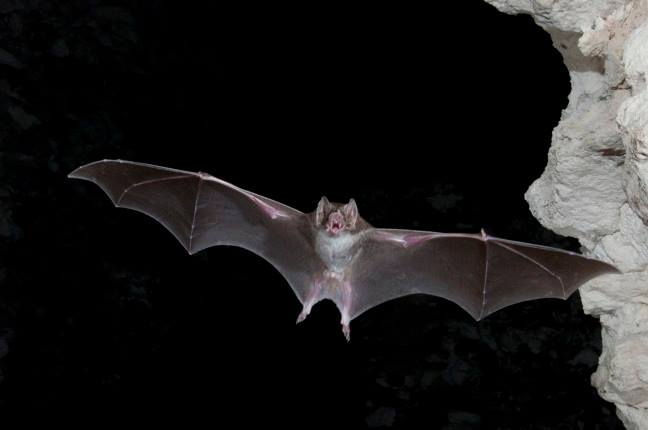Vampire Bats and — Biomimetics?
Guest article by Cowboy Bob Sorensen
Bats have been given a great deal of negative publicity, especially through media. Although they can be pests, they are beneficial. One way is by eating large numbers of insects. Don’t let the nasty, big, pointy teeth throw you off on some, those can be seen on fruit bats such as the flying fox, a scary looking dude with a wing span that can reach about 5-1/2 feet (1.68 m). (Not to be confused with the Soviet Union’s Mikoyan-Gurevich MiG-25 that NATO called the Foxbat.) But most bats are not interested in dealing with people.
They are well-designed by their creator, and many have sonar abilities that are amazing to humans. There’s no evidence of evolution, either.

Vampire bat / Image Credit: Brock Fenton / National Science Foundation
Back in 1968, I was a kid watching the gothic horror soap opera Dark Shadows after school. Barnabas Collins was cursed by Angelique the witch. There was a sound of breaking glass, a big vampire bat attacked him. Normal bats don’t break windows, fly slowly (with the aid of wires on a pole), and zero in on the neck while the victim stand there yelling, “No! Get away from me!” (he should have smacked it silly). Anyway, Barnabas let it bite him, he died, and came back as a vampire.
Actually, vampire legends vary around the world, and vampire bat attacks are seldom mentioned in them. Probably because the critters live in a comparatively small area in the tropics, and only three species of bats are vampires. None are actually evil.
The common vampire bat is small, about 3-1/2 inches (9 cm) with a wing span of 7 inches (18 cm). Instead of an aerial attack on the neck, they move on all fours and give a stealth bite with their pointy teeth. Most victims don’t notice it, and the bats lap up a couple of ounces of blood. That’s right — lap. No suction involved. The “bitten by a vampire bat and turn into a vampire” version of the legends won’t happen, but there is a risk of infection and rabies from the bite.
As a side note for safety: leave them alone. Don’t touch them. Let professionals handle them. Although they are not huge carriers of rabies and diseases, you don’t want to mess around. This guy was bitten on the neck by a bat in the woods because the thing had rabies. That’s the exception, not the rule, and there’s no need to be afraid of bats. Watch them flying around doing bat stuff, admire their sonar navigation, maybe do like some people and put up bat houses for them. Just don’t touch. Savvy?
There is an anticoagulant in the saliva of vampire bats that keeps the blood flowing so the varmint can get filled up for the night. Some scientists were mighty curious about this, and analyzed the anticoagulant. The desmoteplase enzyme has been given a clever name: draculin.
Biomimetics is the means of studying nature and applying what is found there for human use. Robots on water were inspired by water striders, underwater adhesives were inspired by mussels and barnacles, ultrasound sensors for structural cracks were inspired by several things, including bats. Geckos inspired various adhesives before they started working for insurance companies. The field of biomimetics is very active and productive.
Draculin is being studied for treating people for post-stroke blood clots. Yep, vampire bats are potentially giving us unexpected benefits through scientific analysis and applications. God gave us intelligently-designed brains to use, and scientists are deriving many benefits from observing creation and applying what they find. What is extremely ironic is that many scientists believe that life, the universe, and everything came about through time, chance, time, random processes, time, mutations, and time, but there was no Creator involved. But they want to copy the products of trial and error evolution through scientific disciplines and high-tech lab equipment. How about giving credit where it is due?
A fair question asked of biblical creationists: How do blood-eaters fit into a once perfect creation? This has to do with the fall of man in Genesis, and that some moved from eating insects to a blood diet (see link below).
Reference material (listing does not indicate endorsement of evolution-oriented material):
- Flying fox fruit bats
- Meet the World’s Biggest Bat (short video)
- The Night Life: Why We Need Bats All the Time — Not Just on Halloween
- Bats and Sonar
- No Signs of Bat Evolution
- Vampire Legends from Around the World
- Common Vampire Bat
- World’s Weirdest — Vampire Bats (short video)
- Vampire Bat Facts
- Many biomimetics articles and links at Creation Evolution Headlines
- Technical article on draculin
- Article on draculin from US Biological Life Services
- Saliva breaks down blood clots: vampire bats
- Researchers say bat could aid stroke victims
- Draculin, Stroke Drug From Vampire Bats, Moves Closer to Circulation
- The Dracula Connection to a Young Earth




Something was odd with the layout, think I left out a link. The bright red warning in the text above refers to this camper that was bitten by a rabid (but not vampire) bat: http://www.today.com/video/today/56056782